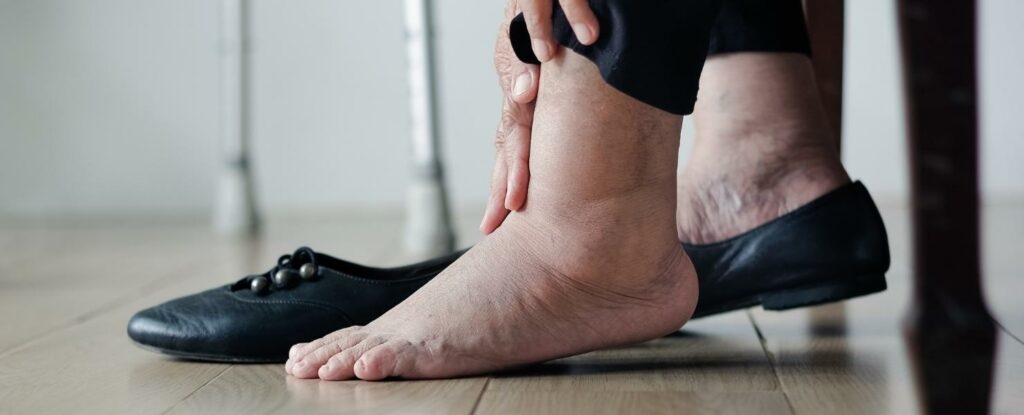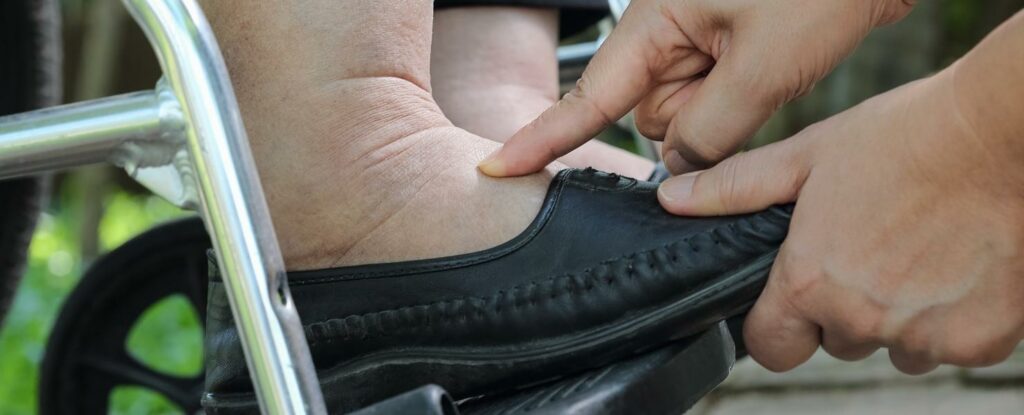If your loved one has swollen ankles, it can be confusing and even upsetting—for them and you. Swollen ankles can be uncomfortable, itchy, even painful. They can make dressing and putting on shoes difficult, and cause sufferers to feel disfigured and worried it will never go away.
What causes this issue? Is it serious? And what can be done to make it better?
You’ve (understandably) got lots of questions about what to do when this concern arises. You’re likely looking for ways to get rid of swollen ankles fast!
This article will walk you through what causes ankle swelling, how to treat it, and when it’s important to seek additional support and attention. So, the next time your loved one experiences it—you’ll know just what to do.
What is Ankle Swelling?



If your loved one is experiencing ankle swelling—don’t panic. This issue is common and impacts many older adults. While it’s important to monitor, it doesn’t necessarily indicate an emergent health issue.
Medical folks often refer to it as lower extremity edema. Edema is a medical term for swelling, and lower extremities encompass your legs, ankles, and feet.
Because they’re on the lower part of our bodies, our ankles often bear the brunt of challenges to our system, thanks in part to good ol’ gravity.
Whether through changes in diet, activity, even the weather—our lower extremities are often where these issues show up physically.
Let’s take a look at some of the common culprits for swollen ankles, so you can assess the likely causes of your loved one’s condition. Then, we’ll examine some ways swollen ankles can be effectively treated.
What Causes Swollen Ankles?



It may seem like a weird, even mysterious symptom, but ankle swelling is often rooted in some pretty common issues.
We’ll break down some of the typical causes of ankle swelling for you, as well as showing you when it should be reported to a qualified healthcare provider.
In general terms, ankle edema is typically caused by a buildup of fluid in this region of the body. This excess fluid is often caused by things like—
- Standing or sitting in one position for long periods of time
- Consuming lots of salty foods
- Being overweight
- A side effect of certain medications, especially certain blood pressure medications, steroids, and antidepressants
Other, more serious causes of ankle swelling include—
- Insect bites and stings
- Injuries like sprains or strains to this region of the body
- Blood clots
- Infections
- Issues relating to the heart, liver, or kidneys
Ankle swelling can also impact the feet, and swollen areas often appear shiny or discolored. The person experiencing it can feel stiff and tight in this region. If the swollen skin is pressed upon, your fingers will often leave an indentation mark that takes several seconds to disappear.
Ankle swelling is common in pregnant women as well as in older adults.
Are Swollen Ankles Serious?
The short answer is—sometimes.
While swollen ankles are a common issue among older adults, they can also indicate underlying health conditions that may need to be addressed and treated by a doctor.
As with any changes you notice when caring for your aging loved one—it’s important to keep a watchful eye when sudden changes occur and to communicate with their healthcare providers if you have any questions or concerns. It’s always better to be safe than sorry.
Because swollen ankles can be a symptom of issues with the heart, kidneys, or liver, it’s important to closely monitor this issue when it occurs.
You should seek medical assistance If your loved one’s ankle swelling doesn’t respond to the treatment strategies we’ll review in the following section, or if they’re accompanied by additional symptoms, such as—
- Difficulty breathing or shortness of breath
- Chest pain, tightness, or pressure
- Fever
- If your loved one’s legs and ankles are red or feel warm to the touch
- If the swelling worsens
- If there’s also swelling in your loved one’s abdomen
Additionally, you should loop in your loved one’s physician if they have known pre-existing health issues including—
- Liver disease
- Kidney disease
- Heart disease (including issues like congestive heart failure)
It’s important to use your best judgment when assisting your loved one in dealing with swollen ankles. You have a deep knowledge and understanding of them, and are in a key position to work with them to make the best healthcare decisions.
In many cases, swollen ankles can be effectively treated at home, without a visit to the doctor. Let’s examine some of your go-to strategies for dealing with this issue at home.
What Are Some Ways To Get Rid of Swollen Ankles?
Thankfully, there are a variety of home remedies for swollen ankles in older adults that are often very effective in addressing this issue.
We’ll take a look at these strategies, as well as why they work—so you can continue to provide your loved one with the help and care they need to enjoy a good quality of life. Hopefully some of these strategies will help you get rid of swollen ankle fast and effectively.
Feet Up



Because a common cause of ankle swelling is fluid accumulation as a result of standing, walking, or sitting too long in one position—a great way to reverse these effects is to elevate the feet and legs off of the floor. This way, built up fluid has a way to redistribute itself.
Hint—it’s important to raise the legs at or above the level of the heart. So, you may need to grab some pillows to achieve this.
Keep an eye on your loved one’s ankles, noticing if the swelling starts to go down after a little while of leg elevation. If so—that’s a good sign!
Compression Stockings



Compression socks and stocking are another way to reduce ankle and leg swelling and pain when they occur.
These garments work by applying gentle pressure to the ankles, legs, and feet, which encourages blood flow from the legs to the heart. This encourages fluid reabsorption and redistribution, and enhances circulation.
Today, there are a wide variety of compression stockings available. If your loved one is experiencing ankle swelling and you want to consider their options for compression socks or stockings, it’s best to schedule a consultation with their doctor first.
Your loved one’s doctor can help determine which type of compression stockings are the best choice, as well as write a prescription. Because compression stockings are a medical device, a physician can help you troubleshoot and choose the best option for your loved one’s needs.
The three main types of compression stockings are—
- Anti-embolism stockings—designed to prevent blood clots from forming in the legs, these are typically used in people who are non or limitedly mobile. They provide different levels of compression, depending on need, with compression typically greater at the ankles and less as they go up the legs.
- Graduated compression stockings—These are typically fitted professionally and offer a wide range of lengths, styles, and levels of compression, depending on the person.
- Support hosiery—this non-medical type of compression stocking offers users uniform compression and less overall pressure than medical varieties. They can help provide relief for ankle swelling and pain. This type of compression stocking doesn’t require a prescription and they can be found at most pharmacies as well as online. There are even companies making these types of stockings in fun patterns and colors, to reduce the stigma of wearing them. Here’s a list of a few, reviewed by The New York Times.
Work It Out
Sometimes, a little activity is the perfect way to reduce ankle swelling when it happens. Even engaging in gentle walking can help improve blood flow, and encourage swelling to go down.
You can also direct your loved one in performing exercises that can help with swollen ankles. Even a seemingly simple exercise like ankle pumps can help reduce swelling.
To learn these and some other helpful exercises to reduce ankle swelling, you can check out this video, demonstrating seven exercises for ankle swelling from a Physical Therapist.
Hydrate, Hydrate, Hydrate



Water is truly our body’s best friend. It can also be helpful in reducing ankle swelling. Keeping your loved one hydrated can help their body process any excess sodium and other waste that can contribute to swelling.
Dehydration is a major issue in older adults. Left unaddressed, this problem can lead to serious health consequences.
You can find creative ways to promote and encourage your loved one’s daily intake of water. Try getting them a cute water bottle, offering them water whenever you’re around, even finding drink mixes or additives they enjoy (if your loved one, like many, tends to avoid plain water).
As a general rule of thumb, it’s always best to encourage your loved one to sip on water throughout the day, rather than chug a lot at once. This way, their body can more effectively absorb and process the hydration they’re getting—rather than flushing it out through elimination.
Another important note—increasing your loved one’s water intake may be contradicted if they’re dealing with a heart condition and need to limit their fluid intake. It’s always best to check with their doctor to make sure there’s no medical reason not to increase their hydration.
Watch the Salt
Because sodium is a major cause of swollen ankles, following a low salt diet can be a big boon in preventing this issue from impacting your loved one’s life.
Because our taste buds age along with the rest of our bodies—older adults can experience reduced sensitivity of their sense of taste. This can lead to people consuming foods that are too heavily salted or sweetened.
These days, many tasty salt alternatives exist—so your loved one can continue to enjoy their favorite foods without the drawbacks and risks. Here is a list of some herbs and spices that offer alternatives to salt.
If your loved one really craves the flavor of salt, here’s a list of some low sodium salt substitutes you can try. It is recommended, however, that you check in with your loved one’s doctor before beginning to use any of these in their diet regularly, just to be safe.
Travel Smart
Traveling can be fun, but it can also be rough on our bodies. This is especially true when it comes to older adults.
While we want our aging loved ones to continue to experience a full, adventurous life, it’s also important to consider their health and wellbeing when traveling, to ensure no issues arise.
Air and car travel can cause and contribute to swollen ankles, so it’s important to consider these factors when planning a trip with your loved one.
Build in movement breaks during longer trips, giving your loved one time to stretch their legs and move around. This will encourage blood flow and circulation, reducing risks for swollen ankles and fluid build-up. You can also remind them every so often to wiggle their fingers and toes, and do some seated ankle pumps.
If they have compression stockings—be sure to pack them and encourage them to wear as indicated.
With these tips and tricks, you’ll soon be helping your loved one get rid of their swollen ankles fast!







